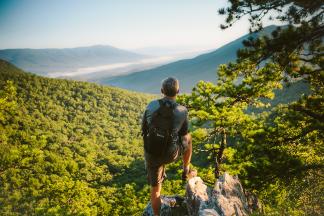Over 600 miles of hiking & biking trails have earned us the title of "Best Trail Town" in the Blue Ridge Mountains.
-
Things To Do
- Arts & Culture
- Attractions
- Beer, Wine & Spirits
- Blue Ridge Parkway
- Events
- Free Things To Do
- History & Heritage
- Kid Friendly
- Nightlife
-
Outdoor Adventure
- Leave No Trace
- Trail Guidelines
- Appalachian Trail
- Biking
- Climbing
- Disc Golf
- Fall Color Spots
- Fishing
- Geocaching
- George Washington & Jefferson National Forests
- Greenways
- Hiking Trails
- Horseback Riding
- Kayaking & Paddling
- Kid Friendly Outdoors
- Motorcycle Touring
- Outdoor Outfitters & Shops
- Scenic Drives
- Water Sports
- Wildlife Viewing & Birding
- Classes & Workshops
- Sample Itinerary
- Sample Itineraries
- Shopping
- Spas
- Sports
- Tours
- VBR Savings Pass
- Hotels/Lodging
- Restaurants
- Region
- Plan
History of Roanoke
Known as the "Capital of the Blue Ridge," and a crossroads for commerce, the City of Roanoke's history began in the 1740s. Mark Evans and Tasker Tosh came from Pennsylvania and took up land near the salt licks where Indian and animal trails crossed in the center of the valley.
For generations, those salt marshes, or licks as they were called, had been a gathering place for buffalo, elk and deer, as well as for the Indians who hunted them.
The salt marshes were to lend their name to the first village in the Roanoke Valley, which started on the east-west path as Gainsborough in 1834. The town soon came to be known as Big Lick.
Roanoke County was formed out of Botetourt County in 1838, with a county population of approximately 5,000. There was an unknown, but certainly not a large, number of slaves in the area.
The town of Salem became the county seat and boasted a population of about 200, with Big Lick numbering about 50 residents. The even smaller community of Vinton was to the east of Big Lick, connected by a narrow brick road.
Railroad History
The railroad came to the valley in 1852, but missed Big Lick. So the little town moved to the tracks, taking its name with it. The original town became Old Lick.
In 1874, the new center was chartered as the town of Big Lick.
Seven years later, with the coming of the Shenandoah Valley Railroad, Big Lick was renamed Roanoke for the river and the county. Roanoke was derived from the Indian word "Rawrenock," a name for the shell beads worn by the Indians and used as trade goods.
In 1882, Roanoke became a crossroads for the railroad, which eventually became the Norfolk and Western Railway. This marked the start of the town's rapid growth, leading to its charter as the City of Roanoke in 1884.
Its historic market, which also began in these early years, remains vibrant as one of the oldest in the country and still operates as an anchor of downtown commerce.
Present-Day Roanoke
Roanoke is now a center for transportation, distribution, trade, manufacturing, health care, entertainment, recreation, attractions and conventions.
Roanoke also has been named the "Festival City." Festivals include the Festival In the Park, Roanoke GO Outside Festival, Henry Street Festival, Virginia Championship Chili Cook-off and Strawberry Festival, to name a few.
The city's most visible attraction is the Roanoke Star, a 100-foot-high illuminated steel and concrete structure, which has been a beacon at the top of Mill Mountain for many years. It stands as a "symbol of the friendliness, industrial and civic progress of Roanoke."
Press releases identified Roanoke as the "Star City of the South." Some nights, the star's glow can be seen from a 60-mile radius and is a landmark for night-time aviators.
Numerous attractions are within an hour's drive of the city, including Dixie Caverns, Salem Museum, The Natural Bridge, the historic towns of Fincastle and Lexington, and Peaks of Otter and Mabry Mill on the Blue Ridge Parkway.
In This Section
Want the latest on Virginia’s Blue Ridge? Securely sign up for our FREE e-newsletter:
Visit Virginia's Blue Ridge 101 Shenandoah Avenue NE Roanoke, VA 24016 (540) 342-6025 (800) 635-5535
Visit Virginia’s Blue Ridge is committed to cultivating an atmosphere that welcomes and celebrates the unique backgrounds, abilities, passions, and perspectives of our vibrant community. As our region’s only destination marketing organization, we have a responsibility to showcase the best the Roanoke Region has to offer, and those assets and strengths come in varied forms. We embrace differences in race, religion, sexual orientation, gender, gender identity or expression, language, visible and invisible disabilities, and all the intersecting identities that make Virginians and visitors alike so unique. We believe our differences make us stronger– and better.








